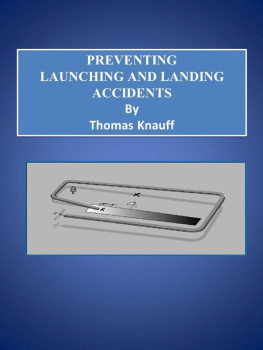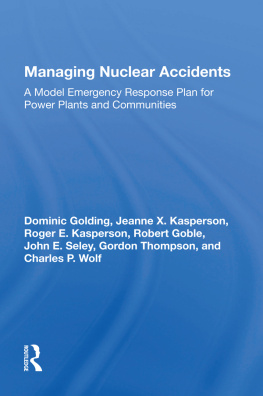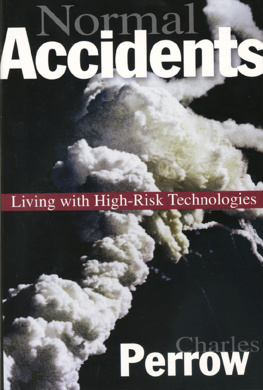MANAGING THE RISKS OF
ORGANIZATIONAL ACCIDENTS
This book is dedicated to two pilots and two surgeons who have greatly enhanced the safety of their respective domains:
Captain Gordon Vette
Captain Daniel Maurino
Dr Lucian Leape
Mr Marc de Leval
MANAGING THE RISKS OF
ORGANIZATIONAL
ACCIDENTS
JAMES REASON

First published 1997 by Ashgate Publishing
Published 2016 by Taylor & Francis
2 Park Square, Milton Park, Abingdon, Oxon OX14 4RN
711 Third Avenue, New York, NY 10017, USA
Routledge is an imprint of the Taylor & Francis Group, an informa business
Copyright 1997 James Reason
James Reason has asserted hir right under the Copyright, Designs and Patents Act, 1988, to be identified as the author of this work.
All rights reserved. No part of this book may be reprinted or reproduced or utilised in any form or by any electronic, mechanical, or other means, now known or hereafter invented, including photocopying and recording, or in any information storage or retrieval system, without permission in writing from the publishers.
Notice:
Product or corporate names may be trademarks or registered trademarks, and are used only for identification and explanation without intent to infringe.
British Library Cataloguing in Publication Data
Reason, James
Managing the risks of organizational accidents
1.Industrial accidents 2. Hazardous substances Safety
measures 3. Industrial safety Management
I. Title
363.1106
Library of Congress Cataloging-in-Publication Data
Reason, J. T.
Managing the risks of organizational accidents / James Reason.
p. cm.
ISBN 13: 978 1 84014 105 4 (Pbk) ISBN 13: 978 1 84014 104 7 (Hbk)
1. Industrial accidents. 2. Risk assessment. I. Title.
T54.R4 1997
658.382dc21 97-24648
CIP
ISBN: 978 1 84014 104 7 (Hbk)
ISBN: 978 1 84014 105 4 (Pbk)
James Reason 1997
All rights reserved. No part of this publication may be reproduced, stored in a retrieval system, or transmitted in any form or by any means, electronic, mechanical, photocopying, recording or otherwise without the prior permission of the publisher.
Published by
Ashgate Publishing Limited
Gower House
Croft Road
Aldershot
Hants GU11 3HR
England
Ashgate Publishing Company
131 Main Street
Burlington, VT 05401-5600 USA
Ashgate website:http://www.ashgate.com
Reprinted 1998, 1999, 2000 (twice), 2001, 2002, 2003, 2004, 2005, 2006, 2008
British Library Cataloguing in Publication Data
Reason, James
Managing the risks of organizational accidents
1.Industrial accidents 2. Hazardous substances Safety
measures 3. Industrial safety Management
I. Title
363.1106
Library of Congress Cataloging-in-Publication Data
Reason, J. T.
Managing the risks of organizational accidents / James Reason.
p. cm.
ISBN 1 84014 105 0 (pbk) 1 84014 104 2 (hbk)
1. Industrial accidents. 2. Risk assessment. I. Title.
T54.R4 1997
658.382dc21 9724648
CIP
ISBN 13: 978 1 84014 104 7 (Hbk)
ISBN 13: 978 1 84014 105 4 (Pbk)
Typeset by Manton Typesetters, 57 Eastfield Road, Louth, Lincolnshire, UK.
Printed in Great Britain by MPG Books Ltd, Bodmin, Cornwall
Contents
ACAA Australian Civil Aviation Authority
ALARP as low as reasonably practicable
AMMS Aurora Mishap Management System
AOC Air Operators Certificate
ASRS Aviation Safety Report System (NASA)
BASI Bureau of Air Safety Investigation (Australia)
BASIS British Airways Safety Information System
BB & Co. Barings Brothers & Co.
BFS Barings Futures (Singapore) Pte Limited
BSL Barings Securities Limited
CEO chief executive officer
CIMAH Control of Industrial Major Hazards
COSHH Control of Substances Hazardous to Health
CRIEPI Central Research Institute for the Electrical Power Industry
CRM crew (cockpit) resource management
EC European Commission
EM error management
EPC error-producing condition
FAA Federal Aviation Administration (US)
FDR flight data recorder
FEA failure mode and effects analysis
FMS flight management system
FSA formal safety assessment
GFT general failure type
HAZAN hazards operability study
HAZOP hazard and operability study
HEA human error analysis
HEART Human Error Assessment and Reduction Technique
HEMP Hazardous Effects Management Process
HRA human reliability analysis
HRO high-reliability organization
HSC Health and Safety Commission
HSE Health and Safety Executive
IAEA International Safety Advisory Group
IDA Influence Diagram Approach
IFSD inflight engine shutdown
INPO Institute of Nuclear Power Operations (US)
JAL Japan Airlines
KB knowledge-based
LII lost-time injury
MEDA Maintenance Error Decision Aid
MESH Managing Engineering Safety Health
MSA Marine Safety Agency
NASA National Aeronautics and Space Administration
NCO non-commissioned officer
NRC Nuclear Regulatory Commission
NTSB National Transport Safety Board
NUREG Report series issued by Nuclear Regulatory Commission
NWA Northwest Airlines
O & M organizational and managerial
PIF performance-influencing factor
PRA probabilistic risk assessment
PSA probabilistic safety assessment
PWR pressurised water reactor
RAMS reliability and maintainability study
RB rule-based
RPF railway problem factor
RBMK A Soviet-built nuclear power plant
SB skill-based
SESMA Special Event Search and Master Analysis
SIMEX Singapore Monetary Exchange
SOP standard operating procedure
SPC Statistical Process Control
SR & QA Safety Reliability and Quality Assurance Program
TBR to-be-remembered
TMI Three Mile Island
TQM Total Quality Management
VPC violation-producing factor
This book is not meant for an academic readership, although I hope that academics and students might read it. It is aimed at real people and especially those whose daily business is to think about, and manage or regulate, the risks of hazardous technologies. My imagined reader is someone with a technical background rather than one in human factors. To this end, I have triednot always successfullyto keep the writing as jargon-free as possible.
The book is not targeted at any one domain. Rather, it tries to identify general principles and tools that are applicable to all organizations facing dangers of one sort or another. This includes banks and insurance companies just as much as nuclear power plants, oil exploration and production, chemical process plants and air, sea and rail transport. The more one moves towards the upper reaches of such systems, the more similar their organizational processesand weaknessesbecome.
In a book of this type the big bang examples inevitably tend to predominate, but, although I have used case study examples to illustrate points, this is not intended to be yet another catalogue of accident case studies. My emphasis is upon principles and practicalitiesthe two must work hand-in-hand. But the real test is whether or not these ideas can eventually be translated into some improvement in the resistance of complex, well defended systems to rare, but usually catastrophic, organizational accidents.
James Reason
There are two kinds of accidents: those that happen to individuals and those that happen to organizations. Individual accidents are by far the larger in number, but they are not the main concern of this book. Our focus will be upon










